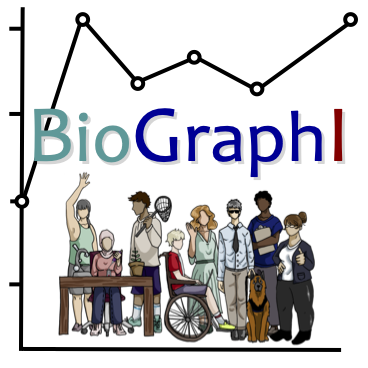BioGraphI FMN Fall 2022
Overview
|
This is a completed Faculty Mentoring Network (FMN). FMNs are sustained, immersive, community-based professional development opportunities for faculty. FMNs support the adaptation and implementation of materials and/or instructional approaches in their classrooms. Learn more about FMNs. Interested in upcoming FMN opportunities? Sign up for the BioQUEST Newsletter Browse products from this FMN Visit partner groups for full resource collections |
Goals
- Develop, implement, and share modules for teaching graph interpretation and fostering diversity in undergraduate biology classrooms by highlighting scientific contributions from biologists who are members of historically excluded groups (HEGs).
- Publish your new BioGraphI module and leave the FMN with more ready-to-use BioGraphI modules covering a variety of biology concepts and featuring diverse scientists.
Mentors
Kristen Butela
University of Pittsburgh
Rachel M. Pigg
University of Louisville
Suann Yang
State University of New York College at Geneseo
I'm a community ecologist with a focus on plant-animal interactions. Being trained as a community ecologist, my scholarly interests with respect to student learning include how the context of interactions among students influences their attitudes toward their learning experiences. Some of my current projects include improving student retention with peer-led workshops, teaching quantitative skills while reducing math anxiety, and developing open educational resources for multidisciplinary sustainability education.
Final Products
In this lesson, learners will learn about cancer genetics and understand and interpret graphs showing quantitative trait locus (QTL) data, survivor curve data, and other genetics data. Then, learners view and reflect on an interview with Deaf biomedical researcher Dr. Megan Majocha, who is doing this research at the National Institutes of Health.
In this lesson students 1) become familiar with various graphs that are used to study diversity patterns within and across sites, 2) learn about some of the questions that can be addressed by metabarcoding studies, and 3) reflect on an interview with evolutionary ecologist Maria Rebolleda Gomez, who collected the data used in the lesson.
In this lesson, learners meet several scientists working on sustainable ways of recycling discarded electronics. Through an interactive H5P activity, participants watch videos and complete a series of knowledge checks. In the process, they meet Jason Williams and learn how Nanopore sequencing works. Importantly, Williams teaches learners how to analyze output from Oxford Nanopore sequencers.

